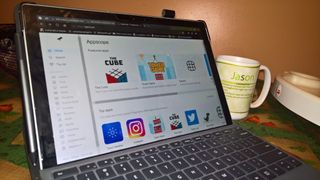Looking for more good Progressive Web Apps, or PWAs? Check out Appscope.
Progressive Web Apps (PWA) are heralded as the evolution of apps and a potential solution to Microsoft's infamous app gap. The creators of Appscope hope to make that happen.

PWAs are hybrid properties that possess the advantages of the web and conveniences of apps. They're discoverable, easily updated and platform-independent. In our connected world an ever-increasing amount of computing occurs in the cloud, browser-based activity dominates users' behavior and constant connectivity fosters leisure and professional collaboration.
Virtually everything we do on our devices has a connected component, and we (particularly digital natives) can barely conceive of computing that is not connected in some way. PWAs seem a natural fit for this reality. In its attempts to make its web and mobile experiences more efficient, Google has invested heavily in PWAs. And in an unlikely partnership Microsoft has been working collaboratively with its frenemy, Google, on the creation of standards to advance PWAs. Other companies including Mozilla and even Apple have shown interest in the technology.
Thus, in our app-driven connected environment, major industry-drivers are signaling that they see a future for PWAs. Appscope founders and childhood friends Carl Unger and Oskar Larsson also see this future. I hashed things out with Unger, and this is what I learned.
The what, where, why and when of Appscope

Appscope was started in April 2018 but officially launched in August. This young Stockholm, Sweden-based company is the brainchild of Unger and Larsson, and it is all about quality PWAs.
After years of developing for iOS, the duo found the app store's model to be problematic in numerous ways — long approval times (even for small updates), limited reach due to ecosystem restrictions, prohibitive development costs due to niche native technologies and non-transparent approval decisions, and more. These limitations motivated the duo to pursue the "openness and free spirit of the web platform."
Unlike native apps with dedicated app stores, however, finding quality PWAs is challenging. As many critics have noted not all PWAs are created equal. Unger and Larsson saw an opportunity to combine the discoverability advantage of native apps, with the openness and freedom of the web and Appscope (appsco.pe) was born.
More than just a storefront

Appscope isn't just a repository of PWAs. There is a deliberate mission driving the small company to have a major impact on a large and as yet unproven space. That won't be easy. Big players like Microsoft and Google have barely moved the needle on PWA adoption, developers are still enamored with traditional apps, and regular consumers are blissfully unaware PWAs exist. Appscope's ambitious mission is to change all of that by enlisting developers, building PWA awareness among consumers and organically growing the PWA ecosystem.
Get the Windows Central Newsletter
All the latest news, reviews, and guides for Windows and Xbox diehards.
Appscope's foundation is an unwavering focus on the quality of the PWAs it features rather than the quantity. "To be listed on Appscope an app must meet the technical criteria for PWAs as well as provide an app-like meaningful experience to a broad audience," says Unger. With such a high standard 2018's already small pool of PWAs leaves an even smaller selection on Appscope's quality-focused platform. 272 to be exact, at the time of my discussions with Unger.
Appscope's goal is to feature PWAs that are great examples of the technology.
Compared to the millions of available apps in an app-focused environment, 272 PWAs sounds paltry, and it is. It's worth noting, however, that we're at the beginning of a computing shift that is becoming even more connected with Always Connected PCs (ACPC). Phones are getting larger, are folding and are becoming more capable of doing more complex tasks. New mobile PC form factors are on the horizon. And 5G and edge computing will keep all of our devices connected all of the time. This creates an environment ready to support the potential wave of PWAs industry-movers Google and Microsoft hope will follow their multi-million dollar investments in the technology.
So even with only 272 apps, with a growth rate of one to two per day (and a projected 300 by year-end), Appscope's positioning to feature only quality PWAs at the beginning of a potential wave of PWAs of varying quality levels is a strategic choice. Given that PWAs are virtually unknown to the general consumer and the technology is still young Unger wants to ensure Appscope's listed PWAs are great technical and user experience examples of PWAs.
Developers, developers, developers
Appscope is deliberate in its relationships with developers. It nurtures these relationships through reaching out, participation in developers forums, providing technical feedback, documentation on how to develop better PWAs and more. These efforts have resulted in the company moving from crawling the web (as Microsoft does) in search of PWAs, to receiving most PWA submissions directly from developers. Unger said:
We believe our system is more advantageous for the growth of the PWA ecosystem since it encourages developers to be more active and intentional with their use of PWA technologies.
Unger also stressed that Appscope's "process is focused on finding web apps that are PWA-first, rather than websites that complement their sites with PWA features without providing an app-like experience." This is a slower process toward achieving the critical mass needed to make PWAs mainstream that large quantities of PWAs would provide. Still, I think the strategy introduces a level of discipline that is better for the general education of what PWAs are, their adoption and growth in the long run.
Unger claims that compared to rivals its system is also more up-to-date than competitors who crawl the web for PWAs since active developer involvement is inherent to Appscope's strategy. The company complements this with daily audits to ensure its listed apps are continuously relevant. Unger believes that its collecting and encouraging high-quality PWA development positions it to attract more users from a broader audience. This, he thinks, further motivates developers.
Reaching the masses

Unger acknowledges that Microsoft and Google have done a great job developing the technology needed for PWA's (like the service workers that enable offline functionality). He believes, however, that now the PWA market must reach the audience beyond developers. Appscope's platform-independent discovery service, for a platform-independent apps, for an audience that uses multiple platforms, Unger believes, is just the tool, the PWA ecosystem needs to grow.
Unger believes that Microsoft will benefit from the increased and broader interest in PWAs Appscope is attempting to generate. Unlike Google that will be merely advancing its web-based computing strategy through PWAs, the technology for Microsoft, is critical to closing its infamous app gap.
Unger acknowledges that PWA's are the "great equalizer." Of course, some apps like social networks and content-focused apps make better PWAs than more hardware intensive applications, such as games. Still, Microsoft enthusiasts are looking toward PWAs as one of the tools in Microsofts app-gap-shrinking toolbox, (along with Project Centennial, Xamarin and others) to help make devices like Microsoft's Centaurus and Project Andromeda more relevant.
Why Google may benefit from PWAs more than Microsoft
Scoping out the future

As we approach the end of 2018, all major browsers and platforms now support PWAs. Windows 10 even natively supports PWAs. "We believe that PWAs are ready for mainstream adoption and hope 2019 will be the start of a growth period. We hope to not only benefit from but also to contribute to the industry growth. As the go-to place for finding PWAs, we expect to attract both more developers and users," says Unger.
Appscope started with 47 apps in April, hopes to reach 300 by year-end and expects to add 1,000 (though they hope for more) in 2019. The company is facing an uphill battle against competitors like PWA Directory, PWA.rocks and Outweb, a general lack of PWA awareness, a modest 25,000 monthly visitors, and the stigma bad PWA experiences has left many users feeling skeptical. Still, whatever the future holds for Appscope PWA's seem to be an inevitable part of our always-connected personal computing future.
Jason L Ward is a columnist at Windows Central. He provides unique big picture analysis of the complex world of Microsoft. Jason takes the small clues and gives you an insightful big picture perspective through storytelling that you won't find *anywhere* else. Seriously, this dude thinks outside the box. Follow him on Twitter at @JLTechWord. He's doing the "write" thing!

